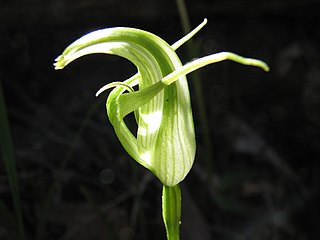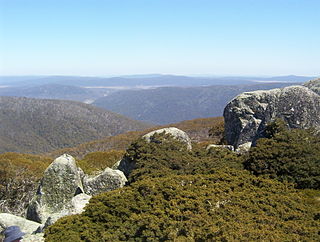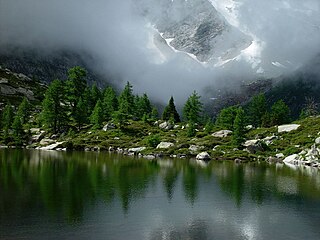
Pterostylis coccina, commonly known as the scarlet greenhood, is a species of orchid endemic to eastern Australia. As with similar greenhoods, the flowering plants differ from those which are not flowering. The non-flowering plants have a rosette of leaves flat on the ground but the flowering plants have a single flower with leaves on the flowering spike. In this species, the rosette leaves are relatively large and dark green, and the flowers are white, and bluish-green or red. It grows in New South Wales and north-eastern Victoria.

Pterostylis curta, commonly known as the blunt greenhood, is a species of orchid found in south-eastern Australia, Lord Howe Island and New Caledonia. It has a rosette of leaves at its base and a single white and green, forward leaning flower with a brown tip and a twisted labellum.

Pterostylis alpina, commonly known as the mountain greenhood, is a species of orchid endemic to south-eastern Australia. It has a rosette of fleshy leaves at the base and usually only one white flower with green markings and back-swept lateral sepals.

Pterostylis baptistii, commonly known as the king greenhood, is a species of orchid endemic to eastern Australia. Flowering plants have a rosette of stalked, dark green leaves and a single white flower with green and brown markings, and a wide gap between the petals and lateral sepals. It occurs mostly in New South Wales but is also found in coastal Queensland and north-eastern Victoria.
Pterostylis aenigma, commonly known as the enigmatic greenhood is a species of orchid endemic to Victoria. It has a rosette of leaves and a single green and white flower which leans forward and has a brownish point on the end. It is a rare orchid, occurring at only one site with fewer than 100 individual plants and is thought to be a natural hybrid between two species that grow nearby.

Pterostylis atrans, commonly known as the dark-tip greenhood or blunt-tongue greenhood, is a species of orchid endemic to south-eastern Australia. As with similar greenhoods, plants in flower differ from those that are not flowering. The non-flowering plants have a rosette of leaves flat on the ground, but the plants in flower have a single flower with leaves on the flowering spike. In this species, the flower is green and reddish brown with a protruding sinus and small club-like tips on the ends of the lateral sepals.

Pterostylis concinna, commonly known as the trim greenhood, is a species of orchid endemic to south-eastern Australia and which usually grows in colonies. It has a rosette of leaves at the base and a single dark green, white and orange-red flower.
Pterostylis furcata, commonly known as the forked greenhood, is a species of orchid endemic to Tasmania. Flowering plants have a rosette of bright green leaves at the base of the flowering stem and a single green and white flower with the tip of the dorsal sepal pointing above the horizontal.

Pterostylis scabrida, commonly known as the rough greenhood, is a species of orchid endemic to Tasmania. It has a rosette of leaves at the base of the plant and a single green and white flower on a rough stem. It is widespread and common in wet forests and is one of the few species of Pterostylis to grow in rainforest.

Pterostylis aneba is a species of orchid endemic to south-eastern Australia. It is a recently described and poorly-known greenhood similar to Pterostylis alpina and P. monticola. It has a rosette of fleshy leaves at the base of the plant and a single green and white flower. It grows in alpine and sub-alpine habitats.
Pterostylis anatona, commonly known as the Eungella greenhood, is a species of orchid endemic to Queensland. It has a rosette of wrinkled leaves at the base of the plant and a single light green and white flower, reddish towards its tip. It grows in higher areas between Eungella and the Blackdown Tableland National Park.
Pterostylis crassichila, commonly known as the plump northern greenhood, is a species of orchid endemic to Queensland. It has a rosette of leaves at the base of the plant and a single white flower with green lines, reddish towards its tip. It grows in higher areas of north Queensland.
Pterostylis dubia, commonly known as the blue-tongued greenhood, is a plant in the orchid family Orchidaceae and is endemic to Tasmania. It has a rosette of fleshy leaves at its base and a dark green and white flower with narrow petals and a dark blue-green labellum.

Pterostylis hildae, commonly known as the rainforest greenhood, is a species of orchid found in eastern Australia. It has a rosette of leaves and when flowering a rosette at the base of a flowering stem with a single green, white and brown flower. It is found in wet forests, including rainforest in New South Wales and Queensland.
Pterostylis procera, commonly known as the short-lipped greenhood, is a species of orchid endemic to Queensland. It has a rosette of leaves and when flowering a single translucent white flower with green and reddish markings and a labellum which does not protrude through the lateral sepals.
Pterostylis riparia, commonly known as the streamside greenhood, is a plant in the orchid family Orchidaceae and is endemic to New South Wales. Both flowering and non-flowering plants have a rosette of dark green, fleshy leaves. Flowering plants have a single relatively large green, white and reddish-brown flower with a deeply notched sinus between hairy lateral sepals.
Pterostylis subtilis, commonly known as the thin mountain greenhood, is a species of orchid endemic to New South Wales. It has a rosette of leaves and when flowering a single translucent white flower with dark green lines, a narrow, deeply notched sinus between the lateral sepals and a curved, protruding labellum.
Pterostylis tanypoda, commonly known as the swan greenhood, is a species of greenhood orchid endemic to New Zealand. Both flowering and non-flowering plants have a rosette of leaves lying flat on the ground and flowering plants have up to seven crowded, inconspicuous bluish-green and white-striped flowers.

Pterostylis torquata, commonly known as the collared greenhood, is a species of orchid endemic to New South Wales. As with similar greenhoods, the flowering plants differ from those which are not flowering. The non-flowering plants have a rosette of leaves flat on the ground but the flowering plants have a single flower with leaves on the flowering stem. This greenhood has a white flower with dark green and dark brown markings, although in some areas, the flowers lack the brown markings. The sinus between the lateral sepals is platform-like.
Pterostylis oreophila, commonly known as the Kiandra greenhood or blue-tongued greenhood is a species of orchid endemic to south-eastern Australia. Flowering and non-flowering plants have three to five dark green, fleshy leaves and flowering plants have a single green and white, sickle-shaped flower with a deeply notched, bulging sinus between the lateral sepals.




















